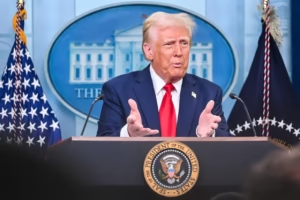President Donald Trump just dropped a bombshell that’s set to shake up the auto industry. Hours ago, he announced sweeping new tariffs on imported cars, with some levies hitting as high as 25%. This isn’t just policy; it’s an economic shockwave aimed at rewriting the rules of global trade, and the fallout is already beginning.
In typical Trump fashion, the announcement came with bold claims about protecting American jobs and punishing countries that have “taken advantage” of U.S. consumers for decades. “When you build a car overseas and sell it here, you’re ripping off American workers,” he declared, framing the tariffs as a long-overdue correction to unfair trade practices. But behind the tough talk, there’s a much more complicated reality—one that could leave car buyers, automakers, and even U.S. workers holding the bag.

The immediate impact? Higher prices. European luxury brands like BMW, Mercedes, and Volkswagen could see sticker prices jump by $5,000 to $10,000 overnight, putting some models out of reach for average buyers. Japanese automakers like Toyota and Honda might dodge the worst of it since many of their U.S.-bound cars are already built in America, but supply chain disruptions could still drive up costs. And if you’ve been eyeing a used import—say, a German sedan or a Japanese SUV—you might want to move fast, because tariffs on new cars could send demand (and prices) for pre-owned vehicles soaring.
The global reaction has been swift and fierce. The European Union wasted no time threatening retaliatory tariffs on $40 billion worth of American goods, from bourbon to blue jeans. Stock markets reacted instantly, with auto stocks taking a hit in after-hours trading. Meanwhile, critics are calling the move a self-inflicted wound, pointing out that many “foreign” cars sold in the U.S. are actually built in American factories—BMW’s South Carolina plant alone employs 11,000 workers. Past tariffs on steel and aluminum under Trump actually led to job losses, not gains, and there’s little evidence this will play out differently.

For consumers, the math is brutal: analysts predict average car prices could rise by at least $3,000, a direct hit to household budgets at a time when inflation is already squeezing wallets. The Biden campaign was quick to pounce, calling the tariffs “a tax on working families,” ensuring this will stay a hot-button issue through the 2024 election. Legal challenges are almost certain, with the World Trade Organization likely to weigh in—and if history is any guide, the U.S. could face hefty fines.
So what happens now? Car dealers will scramble to offload inventory before the tariffs kick in, leading to potential fire sales in the short term. Automakers will reassess production lines, possibly speeding up plans to shift more manufacturing to the U.S. And for anyone in the market for a new ride, the clock is ticking—buying before these tariffs take effect could mean serious savings.
Love it or hate it, Trump’s latest move guarantees one thing: turbulence ahead. Whether it’s economic chaos or a masterstroke of negotiation, only time will tell. But one way or another, the ripple effects will be felt far beyond the auto lot.
